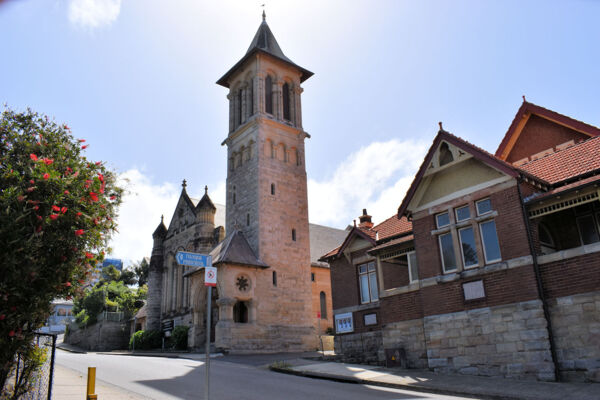Manly, NSW - St Andrew's Presbyterian
Year Built: 1889
Denomination: Presbyterian
Saint: Andrew
Address: 56 Raglan, Manly, New South Wales, 2095
Architect: John Sulman
Architectural Style: Romanesque
Traditional Owners: Gayemagal people
Last Updated: 21/02/2024
History and Architecture:
Designed in the Romanesque Revival style, with Celtic influence and constructed from sandstone with a slate roof, it consists of a nave, vestry and porch dominated by a tall campanile. Walls are generally in rock faced ashlar while quoins and opening surrounds are of smooth dressed finish. The church is considered to be one of the best examples of this style in Australia. The foundation stone was laid in 1889.
The Church was designed by Sir John Sulman, one of Australia’s most eminent architects of the post-Colonial era. Commissioned to design St Andrew’s in 1885.
Clergy:
This list may not contain every serving cleric, past or present, for this church.
Further submissions welcomed.
| Years | Name | Annotation | D.o.B | D.o.D |
|---|---|---|---|---|
| 1886 - 1889 | Rev T. G. Molyneux | |||
| 1896 - 1911 | Rev J. Anderson Gardiner | |||
| 1912 - 1919 | Rev Alex Simms | |||
| 1920 - 1931 | Rev T. Jamieson William | |||
| 1932 - 1942 | Rev A. M. Stevenson | |||
| 1942 - 1955 | Rev Frank Hanlin | 1955 | ||
| 1956 - 1970 | Rev Jack Richardson | |||
| 1971 - 1976 | Rev Donald Simson | |||
| 1977 - 1987 | Rev James Reid | |||
| 1987 - 1994 | Rev Stephen De Plater | |||
| 1995 - 2002 | Rev Anthony Dunmore Lang | |||
| 2002 - 2015 | Rev Derek Bullen | |||
| 2018 - | Rev Duncan Anderson |
Organ:
From its inception the church has shown a particular interest in its music. As early as 1888 a concert was arranged for an organ fund, the substantial amount (at that time) of £30 ($60) being raised. Later a gift of £400 was donated to the fund. In 1889 a letter to Hill & Sons, London, requested specifications for organs costing from £300 to £600 - "something good"!. The quote for £665 was accepted.
A full description and photos can be seen here.
Source:
1. Organ Historical Trust of Australia with permission.
2. Australian Heritage Database.
3. Church website.

